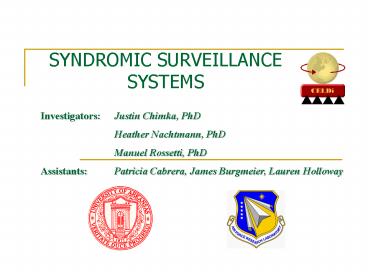SYNDROMIC SURVEILLANCE SYSTEMS - PowerPoint PPT Presentation
1 / 8
Title:
SYNDROMIC SURVEILLANCE SYSTEMS
Description:
SYNDROMIC SURVEILLANCE SYSTEMS Investigators: Justin Chimka, PhD Heather Nachtmann, PhD Manuel Rossetti, PhD Assistants: Patricia Cabrera, James Burgmeier, Lauren ... – PowerPoint PPT presentation
Number of Views:255
Avg rating:3.0/5.0
Title: SYNDROMIC SURVEILLANCE SYSTEMS
1
SYNDROMIC SURVEILLANCESYSTEMS
Investigators Justin Chimka, PhD Heather
Nachtmann, PhD Manuel Rossetti,
PhD Assistants Patricia Cabrera, James
Burgmeier, Lauren Holloway
2
USAF PARTNERSHIP
- The project is related to Decision Support for
Logistics Response to Chemical, Biological or
Radiological Attacks managed by Edward Boyle,
senior research psychologist and chief of the
Logistics Readiness branch of the Air Force
Research Laboratory (AFRL) - AFRL contact is 1Lt Jean-Claude Beasley /
Logistics Research Officer
3
INTRODUCTION
- The earliest detectable sign of a covert germ
warfare attack may be unusual increases in the
number of people seeking healthcare (Reis and
Mandl 2003) - Research objectives
- Compare and evaluate existing detection
algorithms - Develop new methods for improved (influenza-like)
outbreak detection - Formal evaluation of detection algorithms
including enhancements with appropriate attention
paid to distribution assumptions about relevant
public health data
4
BROAD APROACH
- Identify existing algorithms for analysis
- Collect public health data
- Develop enhanced surveillance methods based on
generalized linear models and statistical process
control - Evaluate and compare detection with respect to
sensitivity and specificity
5
MOTIVATION
- The threat of terrorism and high profile disease
outbreaks has drawn attention to public health
surveillance systems for early detection of
outbreaks (Buehler et al. 2004) - In addition we should recognize that the
potential of syndromic surveillance and better
public health data systems in general might be
greater for naturally occurring diseases than for
bioterrorism (Soto et al. 2004)
6
MOTIVATION (continued)
- A better choice of data series and detection
algorithms may be able to improve the balance
between sensitivity and specificity and maintain
timeliness (Soto et al. 2004) - Considerable controversy remains about the best
methods of data analysis and presentation to
facilitate public health decision making based on
surveillance data (Bravata et al. 2004)
7
ACTIVITIES
- Review relevant literature about bio terrorism
- Early statistical detection and monitoring of
outbreaks - Syndromic and public health situation awareness
- Bio surveillance and alert systems
- Methods
- Understand and enhance developed surveillance
systems including current time-series methods - Develop new models for syndromic surveillance
based on weekly surveillance reports of Centers
for Disease Control and Prevention
8
ACTIVITIES (continued)
- Results
- Test model detection capabilities of existing,
enhanced and new surveillance systems - Develop and/or identify additional assessment
capabilities as needed - Conclusions
- Report on important tools for syndromic
surveillance - Recommend alarm strategy based on existing,
enhanced and/or new systems































